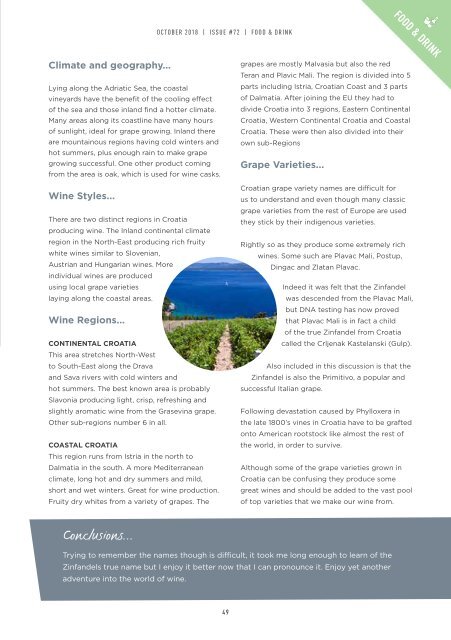Bounce Magazine October 2018
Featuring Echo & Bunnymen, Jazzie B, and regular features!
Featuring Echo & Bunnymen, Jazzie B, and regular features!
You also want an ePaper? Increase the reach of your titles
YUMPU automatically turns print PDFs into web optimized ePapers that Google loves.
FOOD & DRINK<br />
OCTOBER <strong>2018</strong> OCTOBER | ISSUE <strong>2018</strong> #72 | ISSUE | FOOD #72 & DRINK<br />
Climate and geography...<br />
Lying along the Adriatic Sea, the coastal<br />
vineyards have the benefit of the cooling effect<br />
of the sea and those inland find a hotter climate.<br />
Many areas along its coastline have many hours<br />
of sunlight, ideal for grape growing. Inland there<br />
are mountainous regions having cold winters and<br />
hot summers, plus enough rain to make grape<br />
growing successful. One other product coming<br />
from the area is oak, which is used for wine casks.<br />
Wine Styles...<br />
There are two distinct regions in Croatia<br />
producing wine. The Inland continental climate<br />
region in the North-East producing rich fruity<br />
white wines similar to Slovenian,<br />
Austrian and Hungarian wines. More<br />
individual wines are produced<br />
using local grape varieties<br />
laying along the coastal areas.<br />
Wine Regions...<br />
CONTINENTAL CROATIA<br />
This area stretches North-West<br />
to South-East along the Drava<br />
and Sava rivers with cold winters and<br />
hot summers. The best known area is probably<br />
Slavonia producing light, crisp, refreshing and<br />
slightly aromatic wine from the Grasevina grape.<br />
Other sub-regions number 6 in all.<br />
COASTAL CROATIA<br />
This region runs from Istria in the north to<br />
Dalmatia in the south. A more Mediterranean<br />
climate, long hot and dry summers and mild,<br />
short and wet winters. Great for wine production.<br />
Fruity dry whites from a variety of grapes. The<br />
grapes are mostly Malvasia but also the red<br />
Teran and Plavic Mali. The region is divided into 5<br />
parts including Istria, Croatian Coast and 3 parts<br />
of Dalmatia. After joining the EU they had to<br />
divide Croatia into 3 regions, Eastern Continental<br />
Croatia, Western Continental Croatia and Coastal<br />
Croatia. These were then also divided into their<br />
own sub-Regions<br />
Grape Varieties...<br />
Croatian grape variety names are difficult for<br />
us to understand and even though many classic<br />
grape varieties from the rest of Europe are used<br />
they stick by their indigenous varieties.<br />
Rightly so as they produce some extremely rich<br />
wines. Some such are Plavac Mali, Postup,<br />
Dingac and Zlatan Plavac.<br />
Indeed it was felt that the Zinfandel<br />
was descended from the Plavac Mali,<br />
but DNA testing has now proved<br />
that Plavac Mali is in fact a child<br />
of the true Zinfandel from Croatia<br />
called the Crljenak Kastelanski (Gulp).<br />
Also included in this discussion is that the<br />
Zinfandel is also the Primitivo, a popular and<br />
successful Italian grape.<br />
Following devastation caused by Phylloxera in<br />
the late 1800’s vines in Croatia have to be grafted<br />
onto American rootstock like almost the rest of<br />
the world, in order to survive.<br />
Although some of the grape varieties grown in<br />
Croatia can be confusing they produce some<br />
great wines and should be added to the vast pool<br />
of top varieties that we make our wine from.<br />
Conclusions...<br />
Trying to remember the names though is difficult, it took me long enough to learn of the<br />
Zinfandels true name but I enjoy it better now that I can pronounce it. Enjoy yet another<br />
adventure into the world of wine.<br />
49

















